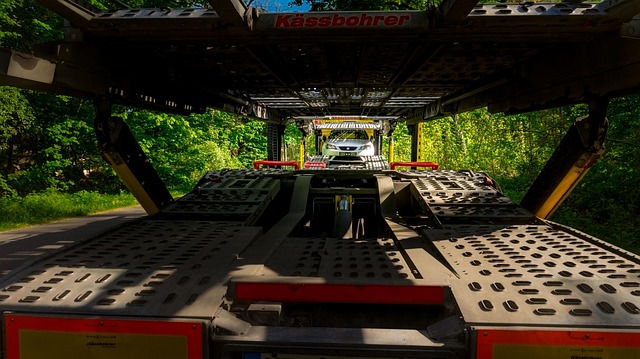Looking to register your car in California? This comprehensive guide walks you through the entire process, from understanding key requirements to finalizing registration. We break down essential steps like gathering necessary documents for VIN verification—a crucial step ensuring your vehicle’s authenticity. Learn the straightforward procedures and necessary fees, making car registration a breeze. Master the art of VIN verification and hit the California roads with confidence!
- Understand California Car Registration Requirements
- Gather Necessary Documents for VIN Verification
- Perform VIN Verification: Steps and Process
- Complete Vehicle Registration Application
- Submit and Pay Fees: Finalizing Registration
Understand California Car Registration Requirements

Before registering your car in California, it’s crucial to understand the state’s specific requirements for vehicle identification number (VIN) verification. California requires a valid, up-to-date VIN inspection as part of the registration process. This is done to ensure that all vehicles on the road meet safety and emissions standards. A mobile vin verifier or mobile vin inspection service can streamline this process by allowing you to complete the VIN verification at your convenience, often without the need for an appointment.
During a VIN inspection, a certified inspector will cross-reference your car’s unique VIN with state records to confirm its authenticity, history, and compliance with California regulations. This includes checking for any outstanding issues, such as recall notices or unpaid tickets, which could delay registration. By utilizing a mobile vin inspection service, you can avoid lengthy waits at designated verification centers, making the process faster and more convenient for busy individuals.
Gather Necessary Documents for VIN Verification

Before you can register your car in California, you’ll need to ensure that all necessary documents are in order and that your vehicle passes a crucial step known as VIN verification. This process involves checking the accuracy and authenticity of your Vehicle Identification Number (VIN). To facilitate this, gather important documents that will be required during the inspection. These include:
1. Your driver’s license or state ID card.
2. The title to your vehicle, if available.
3. Proof of insurance.
4. A valid registration from another state, if you’ve recently moved.
5. If applicable, documents related to any recent repairs or modifications made to the vehicle. Additionally, consider using a mobile vin verifier for a convenient and efficient VIN inspection. This service allows you to quickly verify your vehicle’s history without having to visit a DMV office. Ensure that all documents are up-to-date and accurate to streamline the registration process.
Perform VIN Verification: Steps and Process

To begin the car registration process in California, performing a Vehicle Identification Number (VIN) verification is essential. This step ensures that your vehicle matches the details on record and helps prevent fraud. The VIN is a unique 17-character code that can be found on the vehicle’s identification plate or in its engine compartment. You’ll need to provide this number when registering your car, either online or at a DMV office.
The process for VIN verification involves several steps: first, obtain the vehicle’s VIN from the manufacturer’s certificate of origin or the title document if you’ve already purchased it. Then, compare the VIN with the one listed on California’s database to ensure they match. For added convenience and accuracy, many services offer mobile vin inspection or mobile vin verification, allowing you to complete this crucial step from the comfort of your home or garage.
Complete Vehicle Registration Application

To register your car in California, you’ll need to complete and submit a Vehicle Registration Application (Form DV-140). This form requires essential information about your vehicle, including details like make, model, year, and color. Make sure your application includes the correct Vehicle Identification Number (VIN) as this is crucial for verification purposes.
The California Department of Motor Vehicles (DMV) recommends completing the form accurately and completely to avoid delays. You can also opt for a mobile VIN inspection or use a mobile vin verifier to ensure your vehicle’s details are correct, making the registration process smoother. Once your application is ready, submit it along with the necessary fees to the DMV.
Submit and Pay Fees: Finalizing Registration

After completing the required forms and gathering all necessary documents, it’s time to submit your application and fees for final registration. The California Department of Motor Vehicles (DMV) will process your request and conduct a vin verification to ensure the vehicle’s identification number (VIN) is accurate and matches the make, model, and year specified in the documentation. This step is crucial to maintain the integrity of the state’s vehicle records.
You can pay for registration online or at a DMV field office using various methods, such as credit card, debit card, or check. Ensure you have all the required fees ready to expedite the process. Some individuals opt for a mobile vin inspection or mobile vin verification service, which allows them to get this step done quickly and conveniently without visiting a DMV office in person.
Registering a car in California involves understanding specific requirements, gathering essential documents, and successfully completing several steps, including VIN verification. By following these straightforward procedures and ensuring all necessary information is accurate, you can efficiently finalize your vehicle’s registration. Remember to keep your documentation up-to-date for seamless future transactions and compliance with state regulations.



